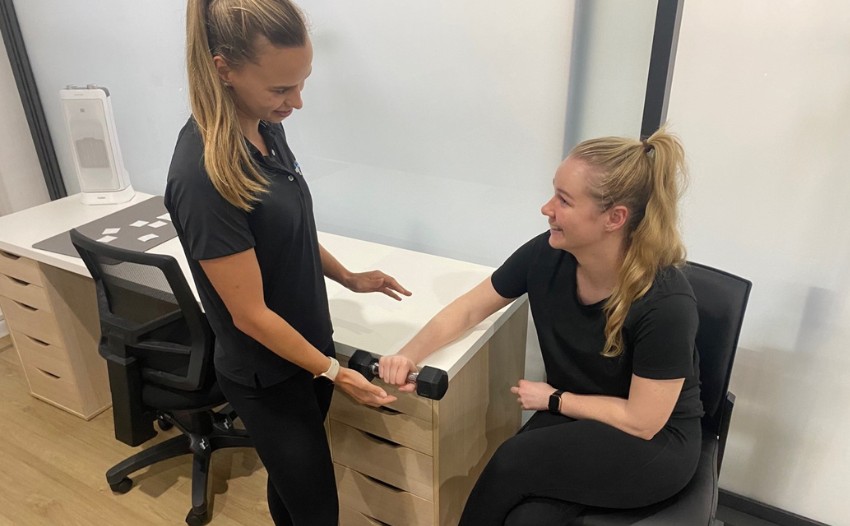
Exercise Physiology / Physiotherapy for Tennis Elbow
What is tennis elbow?:
Tennis elbow, otherwise known as lateral epicondyle tendinopathy, is the most common overuse syndrome in the elbow. Tennis elbow occurs when the tendons that join the forearm muscles on the outside of the elbow become inflamed and damaged. This leads to pain and tenderness on the bony prominence on the outside of the elbow (the lateral epicondyle).
But I don’t play tennis?:
Despite what the name might suggest, tennis elbow is not usually associated with playing tennis. In fact, only 5% of people suffering from tennis elbow relate the injury to tennis! Contractile overloads that chronically stress the tendon near the attachment on the humerus are the primary cause of tennis elbow. It occurs often in repetitive upper extremity activities such as computer use, heavy lifting and forceful forearm pronation and supination. People with repetitive one-sided movements in their jobs such as electricians, carpenters, gardeners, desk bound jobs also commonly present with this condition.
Clinical presentation of tennis elbow:
The most prominent symptom of tennis elbow is pain, which can be produced by palpation on the extensor muscles origin on the lateral epicondyle. The pain can radiate upwards along the upper arm and downwards along the outside of the forearm and in rare cases even to the third and fourth fingers. Furthermore, it is also often seen that the flexibility and strength in the wrist extensor and posterior shoulder muscles are deficient.
Exercise for tennis elbow:
Did you know that exercise is currently the most evidence-based treatment for tennis elbow? The management approach for tennis elbow is adapted from the general principals of tendinopathy rehabilitation. Through exercise, we are able to load the tendon to build new healthy collagen around the old degenerative tendon. This makes the tendon thicker, stronger and more elastic. It is important to note that this process happens slowly (3-6 months), and if too much load is placed on a tendon too quickly, they become susceptible to injury.
There are 3 types of exercise we want to use throughout this process, depending on the stage of the tendinopathy.
- Isometric exercise
- Eccentric exercise
- isotonic exercise
Isometric exercise (which involves contracting the forearm extensors, without moving the wrist) is useful during the acute phase, as it has a pain-relieving effect on the region. It is recommended you perform 5 reps of an isometric contraction for up to 45 seconds, starting with a light contraction, around 25% of your strength.
Once greater loads can be tolerated eccentric exercises (which involves the muscle lengthening to produce a contractile force i.e., going from an extended wrist position to a neutral wrist position), can start to be incorporated. Eccentric exercises have been found to effectively “lengthen” the muscle-tendon complex resulting in structural remodelling of the tendon with hypertrophy and increased tensile strength of the tendon.
Isotonic exercises (where you perform the concentric and eccentric phases of the movement) are the final phase of rehabilitation and should be initiated when it can be performed with minimal pain.
What happens if tennis elbow goes untreated?:
Tennis elbow, if left untreated, can become a chronic medical condition. It is critical to seek treatment as soon as possible for an “acute” case of tennis elbow, one that has developed in the last few weeks. If your symptoms are not assessed and treated promptly by an experienced physiotherapist or Exercise Physiologist, they can last for months or even years. This is especially true if treatment focuses on pain relief rather than repairing the muscle weakness and poor habits/overuse that most likely contributed to the condition.
What would Body Smart Health do for me if I were to schedule an assessment?:
If you were to schedule an assessment with Body Smart Health your physiotherapist or exercise physiologist will ask you questions relating to your medical history, physical health history, actively level and occupation risk factors. Following discussion, your practitioner will complete an array of physical assessment items to determine what is the cause of your pain and create a management plan. Physiotherapists and Exercise Physiologists will also be able to provide education and advice on pain control and where appropriate implement modifications of activities to reduce further flare up.
Manual therapy, such as massage or other techniques, may be used by our physiotherapists. These treatments help to reduce soft tissue and joint tightness, allowing your joints and muscles to move more freely and comfortably.
But remember, there are no two tennis elbows that present the same! To effectively treat your specific tennis elbow, a thorough physical assessment should be completed by our of our Physiotherapists/Exercise physiologists so that an appropriate treatment plan can be devised.
Resources:
- Alexander J, et al. Sonography and MR Imaging of Posterior Interosseous Nerve Syndrome with Surgical Correlation. AJR Am J Roentgenology 2003; 181(1): 219-221
- Goom T. Tendinopathy – rehab progression – part 1. Accessed online at Tendinopathy – rehab progression – part 1 30 Jan 2016
- Page P. A new exercise for tennis elbow that works! N Am J Sports phys Ther 2010: 5(3): 189-193
- Van Rijn R, et al. Associations between work-related factors and specific disorders at the elbow: a systematic literature review. Rheumatology (Oxford) 2009:48(5): 528-536.

Author: Sophie Winter, Exercise Physiologist, B Clinical Ex Phys AEP
Clinic: Sunnybank and Paddington
If you would like to make an initial appointment with Sophie or any of our other available Physiotherapists or Exercise Physiologists, you can contact us on 1300 630 204